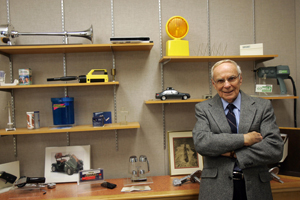
From classic sugar dispensers found in roadside diners to the flashing orange lights that warn motorists of closed traffic lanes, Keck-Craig Inc. in Pasadena has built prototypes of hundreds of now-ubiquitous products.
And it built them the old-fashioned way – with wood, plastic and metal shaped by the skilled hands of engineers. But the 62-year-old company closed its doors March 31 as it faced a hard truth: There’s not much room for old-school in modern manufacturing.
With computer-assisted design programs and 3-D printers – machines that build three-dimensional objects using powdered plastic or other materials – prototypes that used to take days to make by hand now take just minutes. And that technology is improving and getting cheaper by the day, cutting into Keck-Craig’s more labor-intensive business.
“In years past, we had a flow of inquiries without a heck of a lot of need to go chase business,” said Warren Haussler, Keck-Craig’s owner since 1992. “But now the nature of the business has changed. It’s been taken over by rapid prototyping techniques.”
To be sure, it’s more than a changing world that pushed Haussler to close his doors. The business never fully recovered from the recession, especially as corporate research and development spending slowed among its larger clients. What’s more, Haussler is 85 and most of his six employees are at or approaching retirement age. Even if business were better, finding qualified replacements – engineers and designers more comfortable working with their hands than with a keyboard and mouse – could prove difficult.
The need for those skills has diminished rapidly as both production and prototyping have become more automated.
“When I run ads on Craigslist, I can’t say the quality of resumes I’m reading is anywhere near it was 20 years ago,” said Haussler, who used to pluck engineers from aerospace companies. “There are not too many 20- or 30-year-olds who have the skills or the interest in this.”
Faster, cheaper
John Weisman, vice president of sales and marketing at Canoga Park manufacturer Big John Products Inc., said prototypes are still vital. Companies can’t start mass-producing an item based only on drawings or designs.
“You want to hold the thing in your hand before you run with it,” Weisman said. “That’s really critical. What you draw and what comes out is not always the same thing.”
When Big John, which makes toilet seats and other products for the bathroom, needed a prototype recently, the company went to Valencia’s Solid Concepts Inc., which offers 3-D printing, both for prototyping and small-scale manufacturing.
Through its ZoomRP.com online rapid-prototyping division, Solid Concepts can supply a company or inventor with a physical prototype of a new product within 24 hours, all done online and through the mail.
Scott McGowan, vice president of marketing at Solid Concepts, said speed is vital as his company and similar firms hope to stave off competition of their own: 3-D printers that can now be purchased for little more than $1,000.
“You can upload a file today, we’ll print it, ship it overnight and they can have it tomorrow,” McGowan said. “That’s how we’ve kept the prototyping business coming to us.”
The cost of developing a prototype can vary wildly, depending on the complexity of the object and the materials required. But Haussler said on average the prototypes Keck-Craig built took about six months to develop and cost about $75,000 – pricier and slower than Solid Concepts’ offerings.
Founded in 1951, Keck-Craig specialized in designing products that could easily be mass-produced. Much of its business was with corporations such as San Ramon’s Chevron Corp. and Pasadena’s Avery Dennison Corp.
But since the recession, Haussler said business from big corporations has dried up. Despite some manufacturing retuning to the United States, most products are made overseas, and Haussler noted that it often makes sense for prototypes to be made near wherever products will be produced so that potential problems can be ironed out quickly.
The company has also worked with smaller companies and individual inventors, but Haussler said that side of the business was never as steady and certainly not as profitable.
“Inventors frequently don’t have the financing,” he said. “Usually the cost of the work is more than they expect.”
Small scale
But for other prototyping firms, inventors have been a good source of business. Paul Berman, president of T2 Design & Prototyping in Santa Monica, works mostly with inventors and said his business has grown substantially since the recession.
He says the ABC reality show “Shark Tank,” which features entrepreneurs and inventors pitching ideas to high-profile investors, and similar programs have spurred people to turn their ideas into products.
“We have doctors thinking of new housewares, housewives thinking of medical devices,” he said. “It’s like the poker shows: Once people see it on TV, they think, ‘I could do that.’”
Unlike Keck-Craig, T2 hires its engineers and designers as contractors and farms out much of the actual production work to 3-D printing firms, keeping overhead low.
“Companies that build rapid prototypes, they have state-of-the-art equipment, and it’s getting better every year,” Berman said. “The best thing for us to do is outsource that.”
Haussler’s firm has done the same, despite his belief that prototypes made the old-fashioned way are superior to sometimes flimsy 3-D printed versions. Over the past few years, Keck-Craig has built just one in 10 of its prototypes by hand.
That helped to lower costs, but it’s not what Haussler wants to be doing. Were he a younger man, he said he might invest in 3-D printing, but instead he’s chosen to close up shop.
“If we were still around four or five years from now, we’d probably do that, but it’s just not worth buying that technology for me now,” he said.
And though he’ll turn 86 in June, Haussler said he’s not retiring.
“The entrepreneurial attitude is still with me,” he said. “I’m really very positive about the whole damn thing.”
